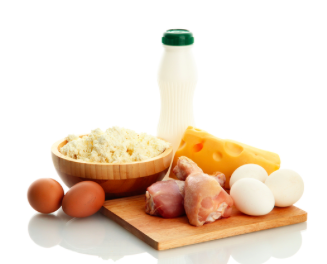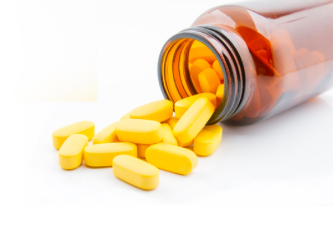Wheying in on the Debate: A Case for the Superiority of Whey Protein
Whey protein has been used in one form or another for at least 300 years, yet it has taken until ...

Whey protein has been used in one form or another for at least 300 years, yet it has taken until ...
Could the numerous benefits of this often overlooked amino contain the key to unlocking your gains? From growth hormone stimulation ...
Question: “We all know that it’s essential for anyone who trains hard to recover sufficiently to continuously improve their performance and physique. What ...
Are the results of your bench pressing, sore shoulders & a flat chest? Time to do things right. Here Ben ...
This inexpensive amino brings with it increased testosterone production & recovery making it a valuable adtiion to your supplement stack. ...
MI40 Strength Coach Adam Miller coming at you with an intro into the world of powerlifting... and how you can ...
Covered:
> Where does hypertrophy training fit into a strength athlete’s training cycle?
> The science of strength
> The 7 fundamental ...
There is, without a doubt, a no more difficult area of the body to develop muscle size and strength, than ...
Muscles store carbohydrates exclusively as glycogen, which is basically a long chain of glucose molecules linked together. The level of ...
In the quest for the perfect physique, hormones often take center stage. Testosterone, estrogen, cortisol, insulin…they get all the glory ...
Bloated stomach? Endless flatulence? Wicked diarrhoea? Believe it or not, you don’t have to live with these symptoms. Ever wonder ...
Let’s face it – seeking out the right information can be confusing whether you are a bodybuilder or just an ...
 In the quest for the perfect physique, hormones often take center stage. Testosterone, estrogen, cortisol, insulin…they get all the glory while so many other naturally occurring chemicals take a back seat. Of those “other” chemicals, the neurotransmitters are a formidable class that often go unnoticed.
In the quest for the perfect physique, hormones often take center stage. Testosterone, estrogen, cortisol, insulin…they get all the glory while so many other naturally occurring chemicals take a back seat. Of those “other” chemicals, the neurotransmitters are a formidable class that often go unnoticed.
The nervous system is mistakenly thought to be controlled by electrical messages, when in fact it is controlled by a careful orchestration of chemical messengers. Many of these chemical messengers belong to the class of compounds called neurotransmitters, of which dopamine is an especially influential member. From the fundamental role it plays in motivation and movement, to the secondary role it plays in testosterone production and fat loss, dopamine is not a chemical to be taken for granted.
The Science
Dopamine is produced in the neurons of the central nervous system and in the adrenal glands, from the common amino acid phenylalanine. Phenylalanine undergoes a metamorphological journey, and comes out the other end in the form of dopamine. More precisely, phenylalanine is converted to tyrosine, which is converted to DOPA and finally dopamine. We should also point out that dopamine is the precursor to another set of very important neurotransmitters, norepinephrine and epinephrine, which themselves serve a multitude of functions vital to health and fitness, not the least of which is fat loss.
We must also take a minute to note that dopamine cannot cross the blood brain barrier. Meaning it cannot enter the cells of the central nervous system from the bloodstream. What this means is that taking exogenous dopamine in any form, whether it be pills or even injections, is completely ineffective. Dopamine that enters the bloodstream will never reach the neurons where it exerts its primary effects. This is why drugs like L-DOPA are the preferred way of increasing dopamine levels, being that they cross the blood brain barrier readily and go on to to trigger the production of dopamine.
The Relevant Stuff
Dopamine is the topic of much research and integral to the understanding of, not just the mind, but the body as a whole. Dopamines many roles are far too numerous and complex to fully flesh out in this article, but there are a few well established functions that are relevant to the bodybuilder and worth pointing out:
Body by Dopamine?
Dopamine’s wide reaching effects undoubtedly play a part in sculpting a lean and muscular physique, but we will need to dig a little deeper to find practicality in this complicated substance.
It’s T-time, lads!
First and foremost, let’s start with the flashiest benefit and the one often found on labels of supplements intended to boost dopamine, testosterone elevation. A prime example is Mucuna pruriens. For those of you who are unfamiliar with Mucuna pruriens, it has gained a lot of traction recently, and is causing quite a stir.  Mucuna is highly sought after and consumed for its high content of the dopamine boosting chemical, L-DOPA. As we mentioned earlier, L-DOPA is the direct precursor to dopamine, and an effective means of boosting dopamine in the brain. Indeed it is so effective that L-DOPA, and even Mucuna pruriens itself, are commonly used in the treatment of Parkinson’s.
Mucuna is highly sought after and consumed for its high content of the dopamine boosting chemical, L-DOPA. As we mentioned earlier, L-DOPA is the direct precursor to dopamine, and an effective means of boosting dopamine in the brain. Indeed it is so effective that L-DOPA, and even Mucuna pruriens itself, are commonly used in the treatment of Parkinson’s.
Several studies have successfully shown rises in testosterone resulting from supplementation of L-DOPA in the form of Mucuna pruriens [3]. Although the gains were modest, they were only seen in individuals with diminished testosterone levels, meaning that people with normal or above average testosterone did not see a boost from supplementation. That being said, it is vital to remember that there are times where testosterone levels can become diminished, such as during periods of intense dieting. On that point about dieting, the high fat diet often adopted by intense dieters has been shown to cause decreases in dopamine as well [4]. Given this information, it may prudent to keep an eye on your dopamine levels around the time when dieting reaches its most extreme levels, a time when low carbs and calories are accompanied by low testosterone and low dopamine. Obviously a blood test or urine screen would be the ideal way of testing your neurotransmitter levels, but since this isn’t easily accessible to most of the population, a Braverman test may be a useful alternative.
Adrenal Fatigue
Another hot topic these days seems to be adrenal fatigue. Adrenal fatigue can simply be described as an exhaustion of the adrenal system brought about by high and prolonged levels of stress, abuse of stimulants, and/or excessive exercise. Although still in its infantile stages, with more research needed to back the claims that some have made, adrenal fatigue is nevertheless something that should be addressed if the goal is to leave no stone unturned.
The prevalence of adrenal fatigue is undoubtedly correlated with the high stress levels of modern life, and the all-too-common abuse of stimulants used to get through it. If not for the morning boost, or the afternoon lull, then it is for the pre-workout jolt, or the fat burning effects — caffeine is everywhere! In fact, some estimates claim that 90% of adults in North America consume caffeine on a daily basis…NINETY PERCENT! [5].
The consumption of caffeine and other stimulants places stress on the adrenal system by way of forcing the system to secrete massive amounts of norepinephrine and epinephrine. If we think back to what we previously mentioned about dopamine synthesis, we are reminded that norepinephrine and epinephrine are made directly from dopamine. Thus, by ensuring that dopamine levels are adequate, we may prevent the depletion of norepinephrine and epinephrine resulting from the use and abuse of stimulants, thereby ensuring the continued efficacy of our supplement arsenal, while mitigating side effects.
On a related thread, a phenomenon known as Central Nervous System fatigue, which is caused by an overactivation of the nervous system elicited by excessive and intense exercise, is thought to be correlated with diminished levels of dopamine [6]. This dopamine depletion is thought to be responsible for the decrease in athletic performance and mental motivation seen with CNS fatigue. Remember how we mentioned that dopamine plays a huge role in movement? Well, that explains the drop in performance, from the drop in dopamine.
To bring this a little closer to home, CNS fatigue can be thought of as a form of overtraining. When the body is pushed beyond its limits, it is not only the muscles that become worn and tired, but the nervous system that also fails to respond. This effect manifests itself as intermittent periods of lowered strength, poor contractions, and disappointing workouts. Although the jury is still out on the true pathology of CNS fatigue, dopamine likely plays a part. So ensuring that your dopamine levels are up to par may help prevent overtraining, and may even promote the effectiveness of an overreaching protocol, a time when overtraining (or overreaching) is the goal.
D-Boosters
So we have learned that dopamine may be a key factor in our quest to be the best, but what can we do to take action? As is the case with manipulation of any chemical in the body, the first line of defense is food. Proper nutrition is the key to ensuring that your body’s chemistry runs like clockwork, and dopamine is no exception.
Food
You are not smarter than your body! Remember that. This is why when approaching matters involving nutrition and supplementation, the best bet is to try and fix things in the most general way possible before progressing to more direct tactics.
 For example, we know that dopamine is synthesized from the amino acid phenylalanine, so the first line of defense in preventing low dopamine is to ensure that you are getting adequate amounts of phenylalanine in your diet. This doesn’t mean supplementation, it simply means consuming plenty of animal protein or dairy (if you can handle dairy), both of which are rich sources of phenylalanine.
For example, we know that dopamine is synthesized from the amino acid phenylalanine, so the first line of defense in preventing low dopamine is to ensure that you are getting adequate amounts of phenylalanine in your diet. This doesn’t mean supplementation, it simply means consuming plenty of animal protein or dairy (if you can handle dairy), both of which are rich sources of phenylalanine.
Given that, as a bodybuilder, you’re probably consuming plenty of protein already, the next tactic would be to supply the body with the next precursor in line for the synthesis of dopamine, tyrosine. Foods that are especially high in tyrosine are poultry and eggs, so be sure to include these bodybuilding staples in your nutrition plan.
Supps
 When food is not enough, we must turn to supplements. The obvious choice here is supplemental tyrosine. Supplemental tyrosine is typically taken in doses of 500-2000mg where it may provide a boost in dopamine, and could even go beyond that to increase norepinephrine and mitigate the effects of stress [7].
When food is not enough, we must turn to supplements. The obvious choice here is supplemental tyrosine. Supplemental tyrosine is typically taken in doses of 500-2000mg where it may provide a boost in dopamine, and could even go beyond that to increase norepinephrine and mitigate the effects of stress [7].
If all that’s not enough, and you want to take things to the next level, then a supplement like Mucuna pruriens is the final weapon in your arsenal. Mucuna pruriens is as close to a prescription dopamine booster that you can get.
Mucuna’s strength lies in its high levels of L-DOPA. The L-DOPA in Mucuna WILL cause an elevation in dopamine, which may lead to subsequent improvements in testosterone (if T levels are abnormally low), mood, cognition, and motor movement – but Mucuna does not come without its share of side effects. Elevated dopamine levels are correlated with conditions like schizophrenia, and people given L-DOPA for treatment of Parkinson’s can present symptoms reminiscent of schizophrenia. Given the high levels L-DOPA found in Mucuna, it is not implausible to suggest that these problems may arise in those who abuse it. As such, it is not only important to follow dosage guidelines found on the supplement label, but to do your own research, and consult a medical health professional before taking any supplements. Proceeding with caution, 5g of Mucuna pruriens seems to be well tolerated in most individuals and is a good place to start supplementation [9].
In Conclusion
We have seen how dopamine can boost testosterone, help with exhaustion, and even prevent overtraining, and we haven’t even begun to scratch the surface. Dopamine boosting drugs have shown impressive brain boosting capabilities, with studies showing notable improvements in learning and memory [8]. Furthermore, understanding dopamine can prove useful in treating eating disorders and obesity (as shown by the work of Dr. Nora Volkow).
Dopamine is an amazing chemical. Fascinating to study, relevant to everything from the mind, to vision, to all sorts of bodily functions, as well as important for fitness and physique enhancement. Dopamine is a chemical that ought to get more attention.
References
[1] Ben-Jonathan, N. “Dopamine as a Prolactin (PRL) Inhibitor.” Endocrine Reviews 22.6 (2001): 724-63. Web. 22 Jan. 2015.
[2] Morley, John E., MB, BCh. “Overview of the Endocrine System.” Merck Manuals. Merck Sharp & Dohme Corp., Sept. 2013. Web. 22 Jan. 2015.
[3] Gupta, Ashish, Abbas Ali Mahdi, Mohammad Kaleem Ahmad, Kamla Kant Shukla, Navneeta Bansal, Shyam Pyari Jaiswer, and Satya Narain Shankhwar. “A Proton NMR Study of the Effect of Mucuna Pruriens on Seminal Plasma Metabolites of Infertile Males.” Journal of Pharmaceutical and Biomedical Analysis 55.5 (2011): 1060-066. Web. 22 Jan. 2015.
[4] Society for the Study of Ingestive Behavior. “A high-fat diet alters crucial aspects of brain dopamine signaling.” ScienceDaily. ScienceDaily, 19 July 2010. Web. 22 Jan. 2015.
[5] Lovett, Richard. “Coffee: The Demon Drink?” New Scientist. New Scientist, 24 Sept. 2005. Web. 22 Jan. 2015.
[6] Davis, J. M., and Stephen P. Bailey. “Possible Mechanisms of Central Nervous System Fatigue during Exercise.” Medicine & Science in Sports & Exercise 29.1 (1997): 45-57. Web. 22 Jan. 2015 .
[7] “L-Tyrosine – Scientific Review on Usage, Dosage, Side Effects.”Examine.com. Examine.com, 22 Jan. 2013. Web. 22 Jan. 2015.
[8] Murphy, Dennis L., George M. Henry, and Herbert Weingartner. “Catecholamines and Memory: Enhanced Verbal Learning during L-DOPA Administration.” Psychopharmacologia 27.4 (1972): 319-26. Web. 23 Jan. 2015.
[9] “Mucuna pruriens – Scientific Review on Usage, Dosage, Side Effects.”Examine.com. Examine.com, 22 Jan. 2013. Web. 22 Jan. 2015.